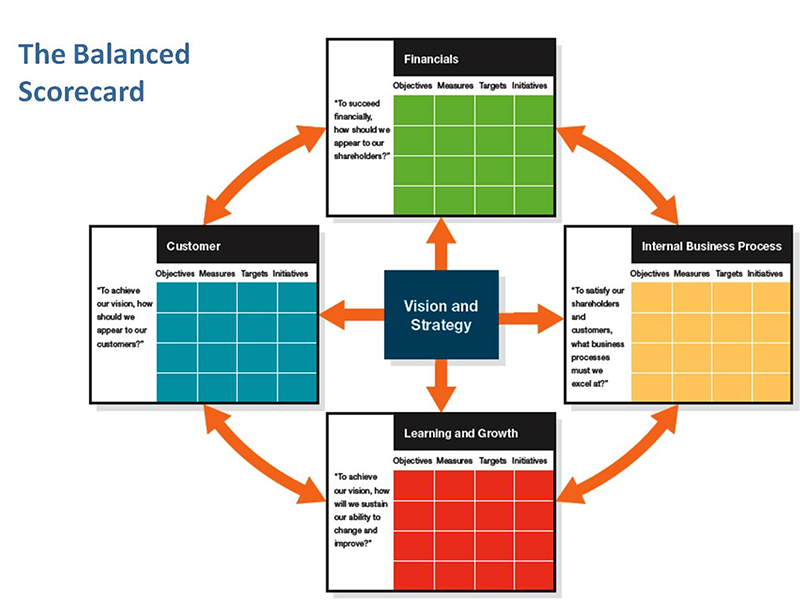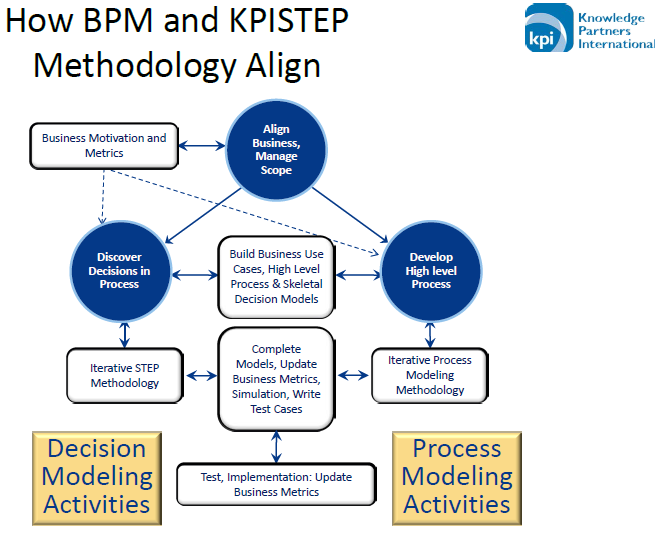Business Performance Management, Balanced Scorecards and The Decision Model
The Decision Model (TDM) is a rapidly growing framework for modeling and executing the business logic behind business decisions. When I first read the book “The Decision Model – A Business Logic Framework Linking Business and Technology” by Larry Goldberg and Barbara von Halle, I was impressed with how TDM models the business logic behind operational business decisions.
However I also wondered if there were any applications of TDM to the practice of strategic management, business performance management and balanced scorecards.
Now with the availability of affordable TDM modeling tools, led by BiZZdesign’s Enterprise Studio, it is now time to revisit and explore the potential application of TDM to business performance management and in particular the Balanced Scorecard.
This post is my attempt to kick-start a discussion in this exciting area of the business enterprise. I hope that others will find other applications of The Decision Model to other business management practices such as Lean Management, Six Sigma and Lean Six Sigma.
The key to successfully implementing a business performance management programme is to understand the importance of the operational business decisions that are executed across all business processes and the business logic that powers these business decisions.
An organization that is able to improve its operational decision-making processes and the business logic used to derive these business decisions can gain a strategic advantage over its competitors, grow shareholders value, increase customer satisfaction and reduce business risks.
Business logic is the means by which an organization reaches conclusions (decisions) based on facts. The Decision Model enables business managers and subject matter experts, using a business friendly graphical notation, to model the business logic behind the business decisions that the business wants to manage.
The key advantage of The Decision Model is that business managers can now explicitly see the business logic behind their business decisions; which can then be fine-tuned in a highly agile matter to respond to the rapidly changing environment that surrounds their business operations.
This post assumes that you know something about The Decision Model. For further background information read this excellent primer on The Decision Model.
For those who do not know much about the practice of Business Performance Management and the Balanced Scorecard, allow me to give a quick overview.
What is the Balanced Scorecard?
The Balanced Scorecard (BSC) is a strategy performance management tool which outperforms the traditional methods of performance evaluation owing to its ability to give an integrated view of the organization, by incorporating both financial and non-financial parameters.
Why do we need the Balanced Scorecard?
A recent article in Business Week said “Business Strategy is now the single most important issue… and will remain so for the next five years”. A recent Fortune article said “Less than 10% of strategies effectively formulated are effectively executed”.
The Balanced Scorecard is now in use by many thousands of corporations and organizations worldwide (including local and national governments), both large, and small. It is one of the most effective tools to implement business strategy. The question we are now about to explore is, how can TDM enable a more effective implementation of the Balanced Scorecard?

Figure 1
Figure 1 shows the four perspectives used by the Balanced Scorecard for implementing strategy and measuring business performance – Financial, Customer, Internal Business Processes, and Leaning & Innovation. The uses of the Balanced Scorecard include:
- It can be used to significantly improve the implementation of objectives and strategies
- It provides a mechanism for controlling and monitoring the organizational progress
- It is a communications device to keep team members up-to-date
- It helps in translating strategy into operational and measurable actions and achieve strategic implementation
Internal Business Processes Perspective and TDM
Let’s look at each of the four perspectives to see where TDM could be applied to improve the effective implementation of an existing Balanced Scorecard within an organization. Let’s start with the “Internal Business Processes” perspective.
The Internal Processes Perspective is all about asking and answering the following questions:
- To satisfy our shareholders and customers, what business processes must we excel in?
- For each business process so identified, what are the strategic objectives that this process should satisfy?
- What are the Measures for each process together with required Targets?
- What new initiatives (if any) are linked with each process to help achieve the strategies objectives assigned to that process?
How to use TDM to Improve the Internal Business Processes Perspective?
The following 8-step procedure is highly condensed and is based in part on the KPISTEP TDM methodology (see Figure 2) and is intended only to outline the key steps of the improvement process for each business process:
- Extract the operational business decisions and business logic that is embedded within the process model as follows:
- For each operational business decision create a blue TDM octagon and give it the business decision as its name.
- Create a high-level glossary containing the fact-types to be used in each Decision Model.
- Create a first iteration high-level Skeletal Decision Model of the business decision.
- Continue to iterate the high-level Skeletal Decision Model in to more detailed models creating finally the Detailed Decision Model, at the same time updating the glossary during each iteration.
- Define meta-data for each Detailed Decision Model that will enable the execution of each rule within a Rule Family to be recorded and to enable subsequent post-mortem of how each execution of a decision model was determined.
- Define decision model measures and metrics that will determine, for example, the value created or cost reduction caused by the execution of each business decision, and link these measures to the Balanced Scorecard Measures and Targets. This will enable the actual contribution of each business decision executed, within a business process, to be accurately determined and then linked to the relevant Balanced Scorecard Measures and Targets.
- Link the process Decision Models created above to the Strategic goals, Objectives and Initiatives. This linkage is useful because for a given strategic goal one will be able to get a report on all the Decision Models across all business process that are implementing operational business decisions that contribute to achieving a given goal or objective.
- Simulate and test each Decision Model and make adjustments to the decision models as required. For more information on Testing Decision Models click here.
- Decide how each TDM model is to be executed. For example, manually, converted to programming code or executed within a business rules engine and with associated decision actions implemented within a business process engine. For more information, see the Modern Analyst article “The Decision Model and Process Models with BPMN”.
- https://www.modernanalyst.com/Resources/Articles/tabid/115/articleType/ArticleView/articleId/1954/The-Decision-Model-and-Process-Models-with-BPMN.aspxIf automation via a rules engine is selected then place each Decision Model, or group of related Decision Models, in a BPMN Business Rule task (which may then be executed within a rules engine) with the results from the execution of the business decision(s) returned to the BPMN process as process variables. Then these process variables may be tested in a BPMN decision gateway and the next process task selected as appropriate.
- Hand your TDM models over to IT to convert them to either software code or rules code that will execute within a business rules engine. TDM tools are now available to automatically convert TDM models to code that will execute in business rules engines which may then be made available as Decision Services within a SOA environment.
 Figure 2
Figure 2
So what is gained by using TDM to improve a Balanced Scorecard’s Perspective?
- Extracting the business logic behind business decisions embedded in a business process, and creating TDM models, enables the value added by each execution of a business decision and its contribution to the overall Balanced Scorecard measures and targets to be determined.This enables the business logic to be easily modified to improve the effectiveness of a business process. This results in highly agile and potentially self-learning business processes.
- It is now much easier to fine-tune a TDM model to improve its efficiency, using this dynamic feedback loop, so over time the business process will continually improve, in the face of changing customer demands and business risks. This is much easier than the standard approach used in pre-TDM days (trying to improve the processes without extracting business logic and business decisions from process models).
- It is much easier to improve and modify TDM models than business process models and also the complexity of business process models are significantly reduced when the business logic is extracted.
So what about the other Balanced Scorecard Perspectives?
A similar principle applies to each of the other BSC perspectives. Let’s have a quick look at the Financial and Customer Perspectives:
- Financial Perspectives: For example many companies, especially large global and financial services companies are concerned about liquidity risk management. TDM models have been used here to significantly improve organizations liquidity and risk management systems.
- Customer Perspective: One of the questions asked in developing a BSC is “How should we appear to our customers?” There have been many initiatives created to address this question including “Treating Customers Fairly” or in improving customer complaints handling. This is just two sample areas where Decision Models could be created to model the business logic to detect customers that are not being treated fairly or to improve the customer complaints management process; thereby ensuring that complaints are managed in a timely and responsive manner.
TDM Modelling Tool Support
Currently there is only one tool that enables the integrated modelling of TDM models, BPMN™ (for Process Modelling), UML® (Fact Type Modelling) and ArchiMate® (Business Motivation Modelling) that is required for Balanced Scorecard improvement projects and that BiZZdesign Enterprise Studio.
To find out more about how Enterprise Studio can be used for integrated modeling of Strategic goals and objectives with TDM see my second post in this series ‘The Decision Model, Enterprise Architecture and Enterprise Studio’.
Conclusion
I hope that I have demonstrated that The Decision Model has the potential to make Balanced Scorecard implementation more effective and agile. Looking forward what I would really like to see is tool support to permit the direct modeling of Balanced Scorecards and their direct integration with TDM models, Business Motivation Models, BPMN models, UML models. Currently we can integrate TDM, Business Motivation (including Strategy Models), BPMN and UML using BiZZdesign Enterprise Studio.

 Figure 2
Figure 2